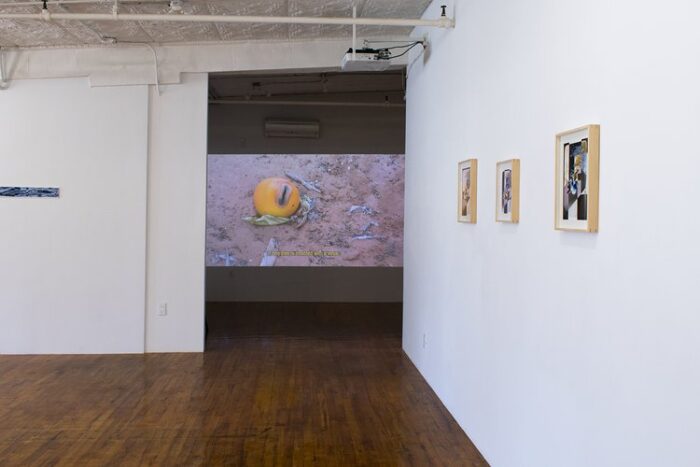
Tristeza II
Installation views, Ulterior Gallery, New York, NY, 2024
Conceived as the world was coming to a halt during the pandemic, Keren Benbenisty’s Tristeza II is a poetic reflection on movement that focuses on return to and migration from one’s supposed homeland. Return and migration seem like opposite moves, but disentangling the “leaving” from the “return” turns out to be impossible. Each movement holds, perhaps is even trapped in, its potential opposite.
Tristeza II, a continuation of a 2021 show that Benbenisty named after the same lethal virus that infects citrus trees, comprises a series of new works without a prescribed sequence. At the center is a 14-minute video narrating the artist’s attempt at cultivating a blue orange. The other works in the exhibition also revolve around the orange and expand on themes raised in the video.
Oranges arrived in Palestine in the tenth century and had become an important export commodity by the mid-1800s. In the 1920s and the early 1930s, oranges cultivated by Muslim, Christian, and Jewish landowners were the leading export product of mandatory Palestine. The following decades witnessed a gradual decline of the citrus industry in Palestine, though the fruit retained its significance for both Palestinians and Zionists as a quintessential symbol of ties to the land. For the Palestinians, especially after 1948, the orange became the signifier of the lost homeland – “the land of sad oranges,” in the words of the Palestinian author Ghassan Kanafani. For the Zionists, the orange symbolized the return to ancestral territory and the emergence of a new, industrious Jewish state.
The video Tristeza documents an unsuccessful attempt to cultivate a blue orange and, in doing so, dwells on the duality of returning to the “Promised Land” and leaving it. The video – which explores pasts, presents and futures-that-could-have-been – is marked by a series of failures: to stay, “to return,” to sink roots, to create a blue orange. And yet, a blue orange, although not the one initially planned, eventually appears. Benbenisty’s private export of oranges does not succeed in transporting the citrus as an edible product. But the blue powder collected from the moldy peels of the “exported” fruit congeals into the primordial landscapes captured on the glass slides that make up the work Survey.
Silencing – titled after “gene silencing,” a process of regulating gene expression in a cell to prevent the emergence of certain traits – substitutes oranges floating on the surface of the Mediterranean for the Hebrew vowel markers (tenu’ot, vocal “movements,” in Hebrew) of the biblical ordinance in Genesis 12:1: “Get thee out of thy country, and from thy kindred, and from thy father’s house, unto a land that I will shew thee.” The Sea, the migratory opposite of the Promised Land, evokes perennial Zionist anxieties about potential destruction. The work frames the failure to fulfill the biblical prophecy, one of the main foundations of Zionist aspirations, as personal and generational: while Keren’s father adhered to the biblical ordinance, Keren erased it after an unsuccessful attempt to return that led to a new departure.
In Grafting, a series of collages made from 35mm slides taken by the artist’s father in the 1960s, Benbenisty mimics the horticultural technique whereby tissues taken from different plants are joined to create a hybrid species, sometimes a more robust species resistant to disease. In the collages, the fusion of the original photographs with a version in which the colors of the original have been inverted results in the selective replacement of orange with blue. The repair tape that holds the collaged pieces together alludes to the wax tape used to seal tree grafts.
The 3D-printed sculpture Untitled recreates a piece of wrapping paper frozen in the form it assumed after wrapping an orange. The work serves as a relic of the lost orange, time and labor of Keren’s maternal grandmother, an immigrant from Morocco who worked in a packaging facility where oranges were prepared for their export from Israel.
The sense of failure and impossibility that threads through the works in the exhibition is the source of the melancholy, Tristeza, which also translates to “feeling blue. As opposed to the other forms of movement to and from the Promised Land, with their clear directionality, the melancholy is all-engulfing. Tristeza is perhaps the land we are shown.
G.B.